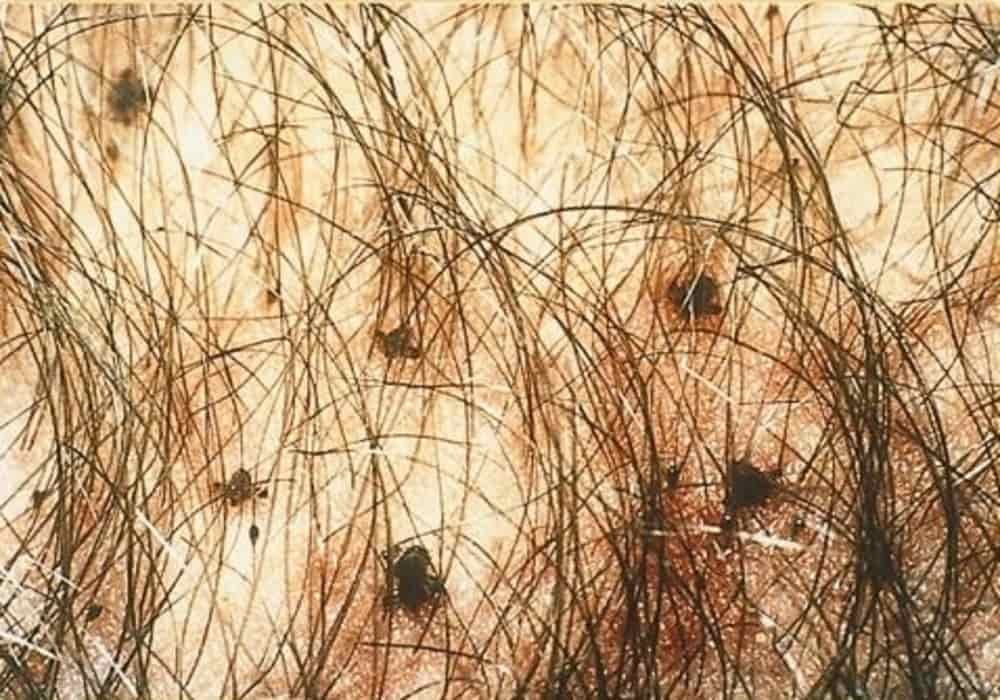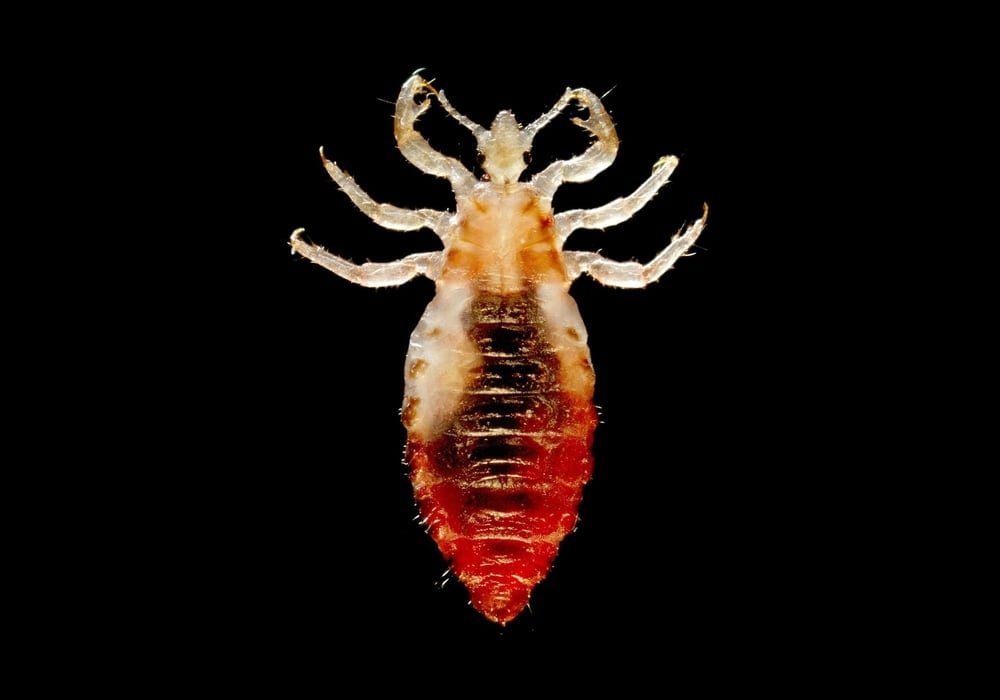Lice (body, head, pubis): treatments, size, photos
Mainly present on the head, in the hair, the lice ou louse is a very resistant parasite which can also be found in other places of the body such as the pubis (crab lice). How do you know if you have lice? What treatments to get rid of it?
Louse (plural: lice)
What is a louse?
“Pediculus humanus” is the scientific term used for the louse. It is a well-known parasite that primarily colonizes the scalp of humans. It feeds on it, which is itchy in about 60% of people who carry it.Lice are parasites, greyish in color measuring about 2 to 4 mm (0,07 to 0,15 inch). A louse lives about 3 to 4 weeks. “Lice cause itching of the scalp, especially at the back of the skull and at the back of the neck”, these are lesions that can become infected.
Sucking lice range in length from 0.5 to 5 mm (1⁄64 to 13⁄64 in).
Types of louse
Pediculus humanus capitis (head louse),
Pediculus humanus corporis (body louse, clothes louse), and
Pthirus pubis (“crab” louse, pubic louse).
Different types of lice (body, head, pubis)
• Head louse
The head louse can only live in human hair. It feeds by sucking very small amounts of blood from the scalp. The female lays eggs, called nits, which spread at full speed.
• Body louse
The body louse, responsible for bodily pediculosis, is much rarer than that of the head. Usually, it is only seen in people with very poor hygiene. It causes itching and scratching lesions that can become secondary. Despite the name, body lice do not directly live on the host. They lay their eggs on fibres of clothing and only come into contact with the host whenever they need to feed. Since body lice cannot jump or fly, they spread by direct contact with another person or more rarely by contact with clothing or bed sheets that are infested.
• Louse pubis or “crab”
Also called crab louse, pubic louse is transmitted during sexual intercourse and mainly affects adolescents and young adults.

Causes and risk factors for the presence of lice
Body lice usually get caught in poorly washed clothes. It is therefore necessary to avoid old clothes and those bought in thrift stores.
For head lice: The main risk factors lie in swapping hats, caps and hats. Very long hair is also to be avoided. Head lice are frequently transmitted in nurseries and schools.
Pubic lice are found mainly in people who multiply sexual partners, even if condoms are used. The more hair you have on your pubis, the more opportunity you have for lice to move around.
Typical signs of the presence of lice
- Body lice are manifested by sometimes violent itching that can leave lesions.
- Head lice cause itchy scalp.
- Pubic lice are itchy. Nits in the pubis are usually found during a doctor’s examination.
Evolution
Adult lice can persist for 24 hours on a pillowcase or cushion. It is therefore recommended to decontaminate tissues and objects in direct contact with the head, washing them at 60 ° C and enclosing them in a plastic bag with an insecticidal powder. Wash sheets, clothes, towels at 60 ° C, and disinfect combs and brushes.
Diagnosis at the doctor
- Body: The diagnosis is confirmed by the presence of scratching lesions and lice visible on the body and on clothing.
- Head: To confirm the diagnosis, the dermatologist will run a fine comb through the patient’s hair and observe with a magnifying glass. The doctor will also check the eyelashes and eyebrows because lice and nits can get caught anywhere there is hair.
- Pubic: During the physical examination, the doctor will notice small gray to black spots near the opening of the hairs. Nits can be visible because they form a small mass attached to the hairs.
Adult lice can persist for 24 hours on a pillowcase.
Treatments
• Body louse: Treatment for body lice usually involves disinfecting the infected person’s laundry and clothing.
• Pubic louse: Treatment is based on the application of pediculicides and lenticides used for head lice. It is essential to treat sexual partners and wash all laundry, especially bath towels.

• Head louse: Treatments for lice are often long and difficult. Treatment for lice can be chemical or mechanical. Different types of head lice products are sold in pharmacies. Ask the pharmacist or doctor for advice among the formulas and brands available (shampoos, lotions, sprays, etc.). Follow the instructions for use indicated on the package leaflet.
The chemical method consists in using an insecticide and / or an ovicide. It is essential to check the mention pesticide against lice (pedilucid) which testifies to the effectiveness of the product. These products are contraindicated in children under 30 months and pregnant women.
Treatments, more “ecological”
The treatments, more “ecological” with mechanical action are composed of oils or silicones which obstruct the airways of the lice, resulting in their death. They can suffocate lice with natural products, such as coconut oil or silicone products. Their handicap is not to be ovocidal and to have to be repeated every 2 weeks or so.
• How to apply the anti-lice product?
Pass a very fine comb through wet hair. Apply the product as soon as you find nits or lice in your child’s head. Do not leave the product on the head beyond the period indicated. Treat strand by strand, making sure the entire scalp is covered with the product.
Apply the product well behind the ears and on the back of the neck. Then rinse thoroughly after the recommended exposure time. Remove nits and dead lice. “Repeat two applications one week after and two weeks later in order to kill the young nits or nymphs that survived the first application. Watch carefully whether any lice have survived the first treatment,” suggests the dermatologist.

Lice in children
As soon as school starts, these little animals make their comeback to school. How do they go from head to head? How to get rid of it effectively? Which treatments to choose and how to wash the clothes to overcome them? Our advice to put an end to these stupid heads.
How do lice get caught in children?
At school, children love to exchange their rubber bands or their hats with their friends. However, this is how lice go from head to head, and crawl from hair to hair thanks to their small hooked legs! Present all year round, the peaks of contamination are particularly found in summer (they love heat and humidity) and during the start of the school year. This is also the case when they participate in collective sports activities or when they are registered in day centers or summer camps, the privileged place for exchanges of these little animals (sharing of pillows, exchanges of headgear, community life…)!
These little animals, lively and resistant to water, have a blast and spread from mane to mane. It starts with itching slightly, then a little more… then a lot! Now, two enemies, however tiny, are to be killed: lice and nits. Did you know ? Lice do not jump, on the other hand, they crawl very quickly (more than 20 cm / min!) On the hair using their small hooked legs. They cannot swim, but can float on water for several hours, are resistant to water and chlorine. Also, to avoid catching them, it is better to each have their comb, their scarf … and not to exchange them. If your child has long hair, it is also recommended to tie their hair up.
How do you know if your child has lice or nits?
Does your child scratch his head from time to time? To find out if he/she has these little animals or nits, look at his hair near the root, and especially behind the ears and the back of the neck. If you see a grayish spot, it may be a slow one. Wedge this point between your thumb and forefinger: “if it remains hooked and can only be removed by sliding it along the hair, it is undoubtedly a slow one”.
How to remove louse and nits (lice eggs)?
On dry hair, use a fine comb, with long, tight teeth, which allows these little animals and nits to be removed effectively. To see them better, stand over a sink or bathtub (or on a white surface) and pour water over them.
Which treatments to choose against lice and nits?
Since it is not always easy to make your child understand that he must avoid being in contact with the hair of his school friends. take the lead! Especially since these little animals can get lodged on all heads, even on clean hair. If the head of your little one has not (yet) been invaded by these little animals, it is still better to have a product on hand to prevent the infestation. Preventive treatment, repellent spray, shampoo, lotion…
Read also: Family Problems | How to Deal with Family Disputes?
The choice is vast. However, pay attention to the composition: a study by Inserm found that one class of insecticides could be harmful to the brains of children. Good news ! More and more manufacturers are offering products without insecticide, paraben, alcohol and prefer formulas with natural active ingredients, more respectful of the scalp. For example, products based on coconut oil or sweet almond will suffocate the lice and eliminate the nits, without attacking the skin. There are even specific rubber bands and scrunchies to eliminate lice, larvae and nits.

Body Lice are parasitic insects and usually live in your clothes and bedding of infested humans.
Some of the external morphologic features displayed by members of the genus Pediculus include an elongated abdominal region without any processes, and three pairs of legs, all equal in length and width. The distal tip of the male’s abdomen is rounded, whereas, the female’s (PHIL# 9202) is concave. Infestation is common, found worldwide, and affects people of all races. Body lice infestations spread rapidly under crowded conditions where hygiene is poor, and there is frequent contact among people. Note the sensorial setae, or hairs that cover the louse’s body, which pick up, and transmit information to the insect about changes in its environment such as temperature, and chemical cues. The dark mass inside the abdomen is a previously ingested blood meal. Photo credit: Janice Harney Carr, Center for Disease Control / Wikimedia Commons
How to avoid lice?
There is no preventive treatment to prevent the appearance of these little animals. A child who has been in contact with a child with lice should be checked for lice. This check should be done at least every 2 days for about 2 weeks. Cutting the child’s hair makes it easier to apply the treatment and use the comb. Shaving the hair is not really necessary and causes anxiety in the child. Tying up girls’ hair helps prevent contamination.
Information: Cleverly Smart is not a substitute for a doctor. Always consult a doctor to treat your health condition.
Sources: PinterPandai, Centers for Disease Control and Prevention (CDC), NHS (UK), Mayo Clinic, Web MD, On Health



